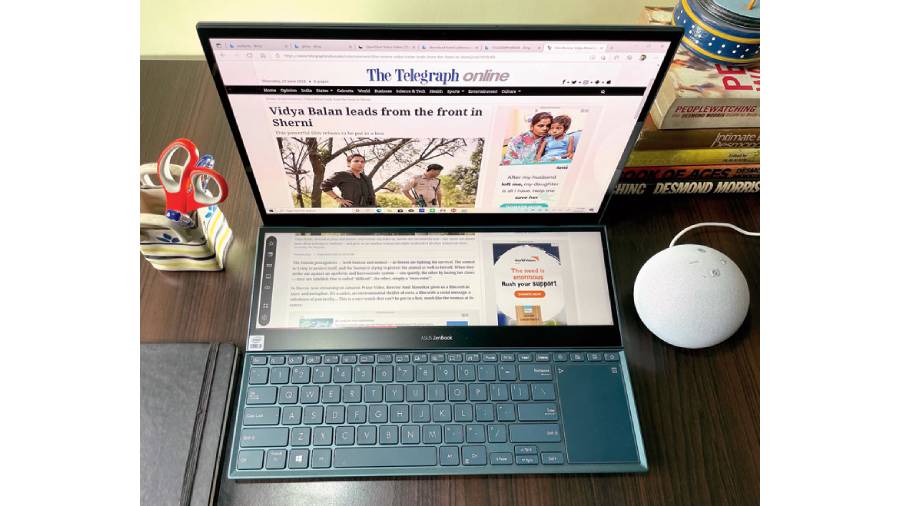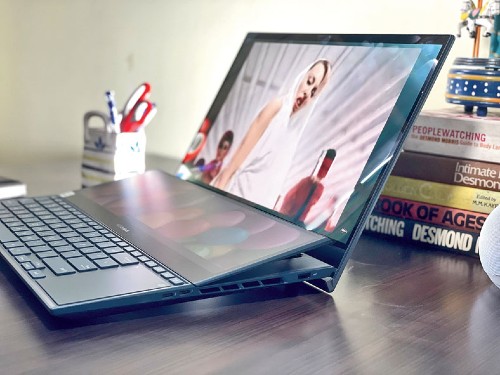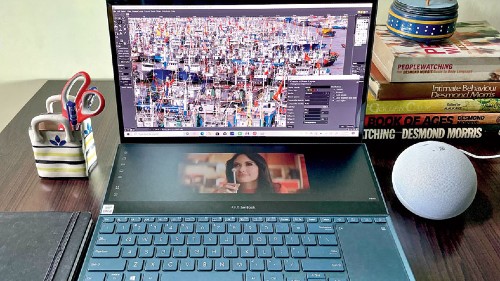Once you use the ASUS ZenBook Pro Duo 15 OLED (UX582), there’s no going back to that ageing desktop. More screen real estate. More speed. More flexibility. This is that “more” laptop that has been developed keeping creators in mind, like video and photo editors, film directors, music producers… you get the drift.
Marriage of two screens
In fact, delving into use cases is a great entry point into understanding the laptop. There are two screens to work on — the primary one and the tilting ScreenPad Plus, a secondary touchscreen that props up to a 9.5-degree angle to tackle glare and reflections. There are several ways the two screens can interact. ScreenPad Plus can be seen as a standalone option for secondary tasks, like watching a live stream while the main screen is where you key in a document. They can become one screen… in a way. For example, while reading a document you can make the text flow from the main screen to the secondary one. And they can also complement each other, which is the most interesting case scenario.
There are three things I keep using my desktop for — video editing, cleaning up audio files and photo editing. All of them are memory-hungry tasks and can be headache-inducing in case you don’t have a good monitor, keyboard and mouse to work with. Let’s take the case of video editing. The device that’s in for review has Intel Core i9-10980HK CPU with 32GB RAM, NVIDIA GeForce RTX 3070 and 1TB M.2 NVME PCIe 3.0 SSD. It’s clear that the machine can handle 4K and 8K footage. Lately, I have been recording some videos on 8K using the Samsung Galaxy S21 Ultra and most of it is difficult to edit on my four-year-old machine. Working on the ZenBook Pro Duo 15 OLED has been free of stutters. The biggest challenge earlier was handling multiple layers and scrubbing through footage while screen area remains limited. This machine allows more control while using, say, Adobe Premiere Pro. All the tools needed can be on the secondary screen. It includes splitting/cutting tools, timeline zoom, marking clips and so on. If all the controls are below, the main screen is left open for editing.

The secondary display is called ScreenPad Plus, which can be used as a shortcuts parking zone for photo and video editing apps, make documents scroll from the primary to the secondary, and much more Sourced by the correspondent
Similarly, while using Photoshop, controls for brush size, opacity, layer zoom in/out, brush tool, brush opacity, brush hardness and so on can be kept on the secondary screen. You can even mix and match what you want on the ScreenPad. The same courtesy is extended to audio-editing tools, like Audacity. If you are broadcasting on Twitch, the lower part is where you can see the video you are transmitting, freeing up the upper half for, say, playing games. A simpler use case is having a Zoom meeting on the main screen while typing a copy or browing on the secondary screen.
And this is a Pantone-validated display, meaning what you see is professional-grade colour accuracy. It has TUV Rheinland-certification as well for low blue-light emissions, making it comfortable to use during long creative sessions.
Mix and match
The second boundary-hitting feature for me is the way users can mix and match how you interact with the laptop. It can be the old keyboard-mouse and screen combination. Or I can use the touchscreen (both displays) freely. And there is a stylus in the box, which is pretty good.
Using the ASUS Pen can be a blessing while video editing and drawing. Going through the timeline to trim/edit becomes a lot easier and having a fast processor helps to work without any lag. The pen can also be a great tool for illustrators. And it can be used on the secondary screen to scribble notes, which gets converted to text.
The secondary screen has a few more goodies. The ones that proved helpful for my workflow is the Quick Key setting, which pops up shortcuts like cut, copy, paste, undo, search and select all. Second is a virtual number keypad. And the third option involves opening up a customised set of windows at the touch of programmable shortcuts. In case I like to work with Photoshop on the main screen while have YouTube playing on the ScreenPad and also have the number pad open, there is a option to make the computer remember this configuration.
They keyboard is as good as on a high-end Dell laptop. There is zero flex and key travel is perfect while working on documents. The two issues I have with the laptop involve the trackpad. First, it’s on the right side, which is good for video editing, but not that efficient while working on documents. Second, if you are left-handed things get complicated.
The other things
The display is obviously among the best but equally important is the way the secondary screen props up a bit and how far back you can tilt the screen. Being a creator’s dream machine, ASUS has thrown in speakers certified by Harman Kardon. The speakers are behind the secondary screen which creates a chamber, giving way to a rich sound. It helps while editing videos. Does the desktop heat up while playing graphics-intensive games such as Resident Evil 2? Yes, it does but the performance is sustained and there are no frame drops.
But don’t expect this machine to be something you can carry everywhere. At 2.34 kg, it’s not the lightest of options for your backpack and being a power monster, there is not much to speak about screen-on time. It’s not a laptop you would like to work on during a long-haul flight.
Should you buy it?
The laptop gives one a sense of direction the industry is moving in — handling complicated tasks like video editing becomes easy with multi-screen support on the same device. The 15.6-inch 4K OLED touchscreen panel delivers magic even though it has a 60Hz screen refresh rate. It’s clearly geared towards the growing-segment of video editors and live streamers, who need the best and the fastest, which ASUS ZenBook Pro Duo 15 OLED (UX582) delivers. It’s big, bold and powerful, like Hulk Hogan or The Rock.
More about the laptop

ScreenPad Plus props up as you push the main display backwards Sourced by the correspondent
Device: ASUS ZenBook Pro Duo 15 OLED
Price: Rs 279,990
High notes
• Excellent combination of dual screen
• Performance beast
• Touchscreen is very receptive
• Stylus included in the box
• Keyboard is a delight
Muffled notes
• The trackpad is on the right side of the laptop making life difficult for the left-handed
Ports
Two thunderbolt 3 USB-C, one USB 3.2 Gen 2 Type-A, one full-size HDMI 2.1, 3.5 mm audio jack and microSD reader










